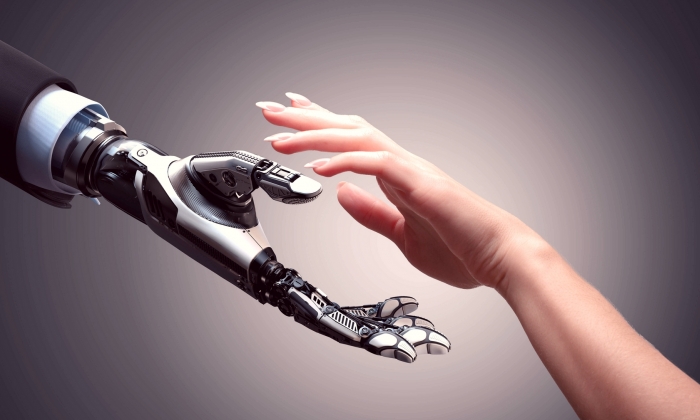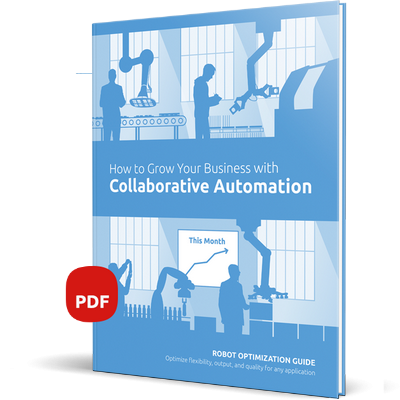Automation for visionaries


Today, monotonous and repetitive tasks in structured production environments are already largely automated around the world. Beyond these applications, industrial automation often still quickly reaches its limits. Companies such as OptoForce are changing this. Haptic sensors give industrial robots a fine sense of touch, significantly expanding the possibilities by enabling complex precision work to be automated.
It’s no secret. Automation is on the march. Most companies have long since recognized the competitive advantage it can lend. With a density of 301 industrial robots installed per 10,000 workers, Germany is the fourth most automated country in the world – out-automated only by South Korea, Singapore, and Japan. Collaborative lightweight robots, which can work directly next to or together with humans without requiring protective cages, so-called “cobots”, have made a particularly significant contribution to that number in the past few years.
However, for a task to be automated solely with the conventional combination of robotic arm and end effector, it must meet a whole series of requirements:
- Its workpieces must be objects with standardized dimensions.
- These objects should also consist of materials that resist deformation.
- It is also necessary for objects to be located precisely, in positions preprogrammed into the robot.
The result: the ones automated today are primarily monotonous and repetitive tasks that are less demanding.
The challenge: breaking out of the box
If the complexity of a task goes beyond this “box”, automation quickly meets its limits – and so large parts of industry are still in baby shoes even today. Unstructured production environments and sensitive materials, after all, are no longer exceptions to the rule. This type of precision task requires a robot to have sensitivity and the capacity to adapt waypoints in real time to achieve the desired results. OptoForce, a manufacturer of six-axis force/torque sensors in Budapest, Hungary, has taken on this problem with the goal of giving lightweight robots a sense of touch. The haptic sensors produced by the young Hungarian company offer a whole series of new applications for industrial robotics – giving automation new perspectives.
Looking at industrial production facilities right now, many of these precision tasks are still handled manually:
- By human hands that can handle sensitive materials with care.
- That can detect during assembly whether part A has been connected correctly to part B.
- That can simply pick up workpieces placed in a container in an unstructured manner by feeling them.
Even so, it is becoming increasingly difficult to find human workers for this kind of job – hardly anyone wants to do these monotonous routine tasks.
Corporate groups have reacted to this fact for years and decades by moving simple production steps to low-wage countries, while midsized companies are often left with the need to find expensive, less efficient regional solutions. Haptic force/torque sensors now offer widely applicable options for automating new processes, significantly increasing the efficiency of production.
The human workforce is thus freed of monotonous, repetitive tasks and can devote their attention to more demanding work steps.
Versatile in application
- Whether in support of automating precision tasks such as precision assembly, surface refinement, or packaging,
- as a monitoring tool for quality control or data collection,
- or as a “catalyst” for the integration process, thanks to the software package included, which contains a variety of standard industrial applications,
force/torque sensors are versatile in application. The haptic sensors are connected between the robotic arm and the end effector, with a robust layer of elastic plastic measuring the forces acting along the XYZ axes. The sensors measure about 1,000 items of process data per second – giving the robot direct feedback on whether and how it must adapt its path to the desired goal. The hardware is directly compatible with industrial robots made by KUKA, ABB, andhttp://sensitiveautomation.com/en/2017/11/02/applications-for-haptic-sensors/ Universal Robots.
Advantages in comparison with image processing
This data flow offers several advantages over cameras and other image processing systems, which simply capture “still life” images and then act on the basis of this rigid input. Only in a few cases is the delivery and processing of and reaction to process data possible in real time – and that is associated with significant effort. In unstructured production processes – in the sense of workpieces not always located in exactly the same place – haptic sensors thus provide a significant advantage. Even in many structured processes, the “hand” beats the “eye” – for example in the precision insertion of pins into a given opening without play, or when working with glossy surfaces. In applications like these, the error susceptibility of robotic systems can be significantly reduced by implementing sensors.
Quick setup thanks to software included
A significant differentiating feature of OptoForce is the inclusion of a complete integrated package. Thanks to the software applications included, the sensors are ready to operate in less than 15 minutes.
The software package included contains a variety of standard industrial applications such as palletization, polishing, stacking, and hand guidance, and is always being extended with new applications. Thanks to its intuitive integration into the user interface of the robotic arm, even untrained employees without programming skills can easily implement the corresponding applications in a short time.
Automation perspectives
These force/torque sensors, weighing only 260 grams, may be a literal lightweight, but they should have a hefty influence on industrial manufacturing in the German-speaking region.
Thanks to the new perspectives they offer in process automation, as well as the volume of precision data they can feed into a smart factory, force/torque sensors have the potential to become a real game changer in industrial robotics – setting off a domino effect of changes from process design to personal development to planning reliability.
In the evolution of lightweight robots with rapid economic and long-term strategic effects on manufacturing companies, the sense of touch is the logical next step.

|
Hoe uw bedrijf laten groeien met collaboratieve toepassingen
Met het aanbreken van slimmere, meer adaptieve gereedschappen kunnen robots nu met meer snelheid, kracht, veiligheid en precisie functioneren en een brede waaier aan taken uitvoeren, terwijl de ROI wordt gemaximaliseerd. Leer meer over hoe u een snellere productie tegen lagere kosten mogelijk kunt maken door ons gratis eBook te downloaden.
DOWNLOAD HET GRATIS eBOOK
|

|

